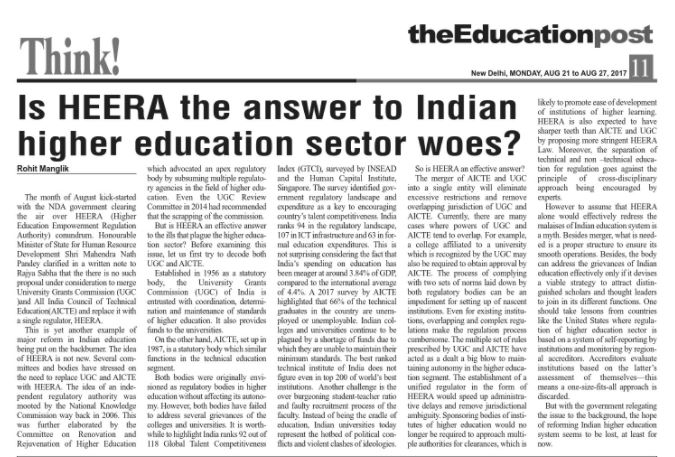The Education Post Reports – Is HEERA the answer to Indian higher education sector woes? Read the expert’s views.
ROHIT MANGLIK
The month of August kick-started with the NDA government clearing the air over HEERA (Higher Education Empowerment Regulation Authority) conundrum. Honourable Minister of State for Human Resource Development Shri Mahendra Nath Pandey clarified in a written note to Rajya Sabha that the there is no such proposal under consideration to merge University Grants Commission (UGC )and All India Council of Technical Education(AICTE) and replace it with a single regulator, HEERA.This is yet another example of major reform in Indian education being put on the backburner. The idea of HEERA is not new. Several committees and bodies have stressed on the need to replace UGC and AICTE with HEERA. The idea of an independent regulatory authority was mooted by the National Knowledge Commission way back in 2006. This was further elaborated by the Committee on Renovation and Rejuvenation of Higher Education which advocated an apex regulatory body by subsuming multiple regulatory agencies in the field of higher education. Even the UGC Review Committee in 2014 had recommended that the scrapping of the commission.But is HEERA an effective answer to the ills that plague the higher education sector? Before examining this issue, let us first try to decode both UGC and AICTE.Established in 1956 as a statutory body, the University Grants Commission (UGC) of India is entrusted with coordination, determination and maintenance of standards of higher education. It also provides funds to the universities.On the other hand, AICTE, set up in 1987, is a statutory body which similar functions in the technical education segment.Both bodies were originally envisioned as regulatory bodies in higher education without affecting its autonomy. However, both bodies have failed to address several grievances of the colleges and universities. It is worthwhile to highlight India ranks 92 out of 118 Global Talent Competitiveness Index (GTCI), surveyed by INSEAD and the Human Capital Institute, Singapore. The survey identified government regulatory landscape and expenditure as a key to encouraging country’s talent competitiveness. India ranks 94 in the regulatory landscape, 107 in ICT infrastructure and 63 in formal education expenditures. This is not surprising considering the fact that India’s spending on education has been meager at around 3.84% of GDP, compared to the international average of 4.4%. A 2017 survey by AICTE highlighted that 66% of the technical graduates in the country are unemployed or unemployable. Indian colleges and universities continue to be plagued by a shortage of funds due to which they are unable to maintain their minimum standards. The best ranked technical institute of India does not figure even in top 200 of world’s best institutions. Another challenge is the over burgeoning student-teacher ratio and faulty recruitment process of the faculty. Instead of being the cradle of education, Indian universities today represent the hotbed of political conflicts and violent clashes of ideologies.So is HEERA an effective answer? The merger of AICTE and UGC into a single entity will eliminate excessive restrictions and remove overlapping jurisdiction of UGC and AICTE. Currently, there are many cases where powers of UGC and AICTE tend to overlap. For example, a college affiliated to a university which is recognized by the UGC may also be required to obtain approval by AICTE. The process of complying with two sets of norms laid down by both regulatory bodies can be an impediment for setting up of nascent institutions. Even for existing institutions, overlapping and complex regulations make the regulation process cumbersome. The multiple set of rules prescribed by UGC and AICTE have acted as a dealt a big blow to maintaining autonomy in the higher education segment. The establishment of a unified regulator in the form of HEERA would speed up administrative delays and remove jurisdictional ambiguity. Sponsoring bodies of institutes of higher education would no longer be required to approach multiple authorities for clearances, which is likely to promote ease of development of institutions of higher learning. HEERA is also expected to have sharper teeth than AICTE and UGC by proposing more stringent HEERA Law. Moreover, the separation of technical and non –technical education for regulation goes against the principle of cross-disciplinary approach being encouraged by experts.However to assume that HEERA alone would effectively redress the malaises of Indian education system is a myth. Besides merger, what is needed is a proper structure to ensure its smooth operations. Besides, the body can address the grievances of Indian education effectively only if it devises a viable strategy to attract distinguished scholars and thought leaders to join in its different functions. One should take lessons from countries like the United States where regulation of higher education sector is based on a system of self-reporting by institutions and monitoring by regional accreditors. Accreditors evaluate institutions based on the latter’s assessment of themselves—this means a one-size-fits-all approach is discarded.But with the government relegating the issue to the background, the hope of reforming Indian higher education system seems to be lost, at least for now.
You Might Want To Read:
Delhi University M A English 1St Year Mock Test Paper 3, Ecgc, Masters Digital Photography Scheme Mdps Vs Fx School, Rpsc Fisheries Development Officer Fdo Online Test, Doeacc C Level Multimedia Technology And Virtual Reality Mock Test Paper 45, Delhi University L L B 2Nd Year Mock Test Paper 1 7, Uttarakhand Public Service Commission Ukpsc Online Mock Test, Labor Welfare Solved Question Paper 4 2012, Exam Formula Sbi Po Prelims Mains Test Series, Sbi Po Pre Sample Paper With Solutions Set 02
Leave your vote
This post was created with our nice and easy submission form. Create your post!








Comment